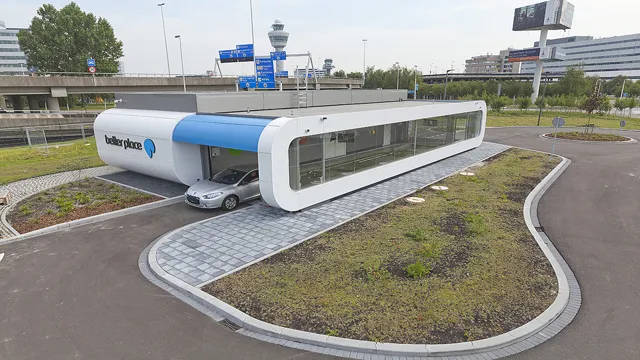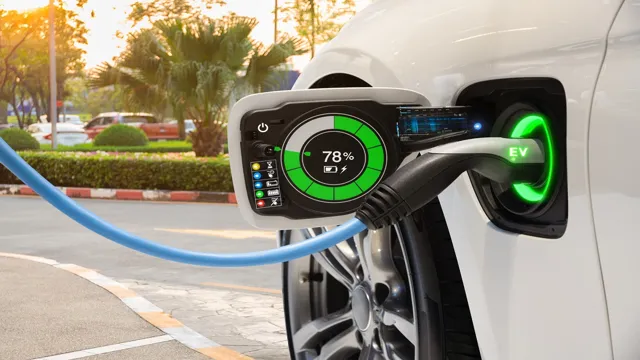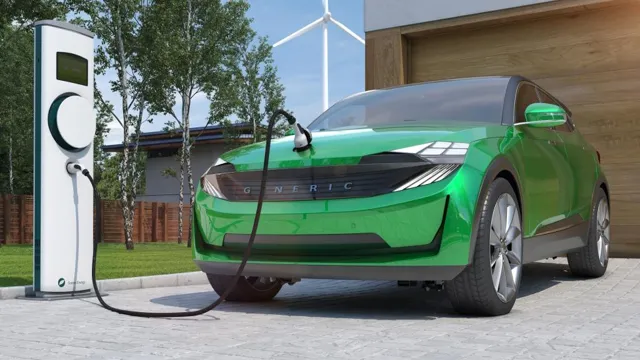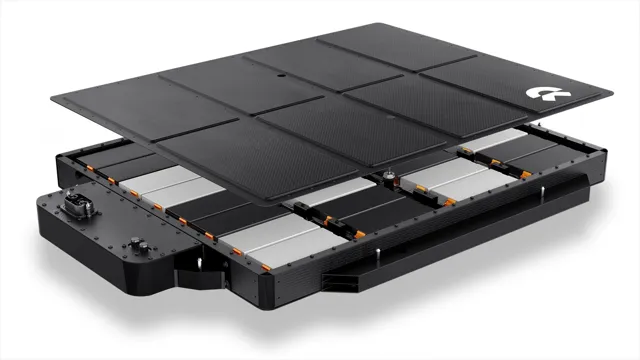Revolutionizing Electric Cars with Efficient Battery Exchange System
Switching to electric cars has become increasingly popular in recent years. They are cleaner, greener, and offer a more environmentally friendly and sustainable transportation option. However, one of the biggest issues that still deters people from making the switch is the limited range of electric car batteries.
Charging stations are not ubiquitous yet and, as a result, drivers can end up stranded with no battery power. Fortunately, with the development of electric car battery exchange systems, this issue may soon be a thing of the past. This revolutionary technology offers drivers the ability to swap their depleted battery for a fully charged one in record time, minimizing the inconvenience of waiting for a recharge.
Electric car battery exchange stations are popping up across the world, providing drivers with the peace of mind they need when it comes to their car’s power supply. This innovation will not only make electric cars more practical and convenient but will also reduce the overall cost of owning an electric vehicle. Drivers will no longer need to invest in expensive high-capacity batteries, which not only have higher replacement costs but also take longer to recharge.
With a battery exchange system, drivers can pay a smaller fee to exchange their battery for a fully charged one. In conclusion, the introduction of electric car battery exchange systems is a major step forward in the evolution of electric cars. This technology is making electric cars a more practical and economical choice for drivers who want to contribute to a greener future.
With the installation of more battery exchange stations and advancements in battery technology, the future of electric cars looks bright.
What is a battery exchange system?
An electric car battery exchange system is a solution that allows electric vehicle owners to quickly and easily change their car’s battery rather than waiting for it to charge. This type of system involves having charging stations with pre-charged batteries ready to swap out with the depleted batteries in electric cars. This system solves the issue of range anxiety, where electric car owners may worry about running out of battery charge while on a long trip.
Additionally, it takes significantly less time to swap a battery than to fully charge one, making it ideal for drivers who have limited time for a charging session. In short, an electric car battery exchange system provides convenience, accessibility, and peace of mind to electric vehicle owners.
Explanation of how battery exchange system works
A battery exchange system is a method for providing electric vehicle drivers with a convenient and efficient way to replace their vehicle’s battery. Rather than having to wait for their battery to charge, electric vehicle owners can simply exchange their depleted battery for a fully charged one at a battery swapping station. The process is similar to filling up a gas tank, but without the harmful emissions.
The battery exchange system operates by having a network of battery swapping stations throughout a city or region, making it easy for drivers to locate a station nearby. Once at the station, the driver can remove their depleted battery and replace it with a fully charged one. This system also provides an eco-friendly solution for battery disposal, as the depleted batteries are collected and recycled.
The battery exchange system is an innovative and practical solution that makes electric vehicles more appealing to the masses and can help reduce carbon emissions.
History of battery exchange system and how it’s improved
A battery exchange system is a program where batteries are exchanged for a fee. This system was first introduced in the 1800s but didn’t gain popularity until the 1900s. It started as a way to power telegraphy equipment, but as cars and other machines started using batteries, the battery exchange system became more common.
One of the benefits of this system is that it allows consumers to use high-quality batteries at a lower price. The batteries provided by battery exchange systems are better quality than those sold in stores because exchange systems can afford to invest in higher-quality batteries. The battery exchange system also helps with the problem of battery waste.
Instead of throwing batteries in the trash, users can exchange them for new ones, which can then be recycled or properly disposed of. Over time, the battery exchange system has improved. New technologies have emerged, making the system faster and more efficient.
Today, battery exchange systems are an attractive option for businesses looking to cut costs while still meeting their energy needs.
Benefits of electric car battery exchange system
An electric car battery exchange system is a revolutionary solution for electric vehicle users. There are many benefits to using an exchange system, such as the convenience of quickly swapping out a drained battery for a fully charged one at specialized stations. This eliminates the need for long charging times, which can sometimes be a hassle.
Additionally, an exchange system can be more sustainable than charging batteries, as it allows for the use of renewable energy sources to power the stations that provide the exchange service. Moreover, it can increase the lifespan of electric vehicles by eliminating the risk of battery degradation over time. Finally, the system can reduce the overall cost of owning an electric vehicle by eliminating the need for battery replacements, which can be quite expensive.
All in all, an electric car battery exchange system can be a game-changer for the electric vehicle industry, enabling users to enjoy a more convenient, sustainable, and affordable electric driving experience.
Reduced charging time and increased range
An electric car battery exchange system offers many benefits, including reduced charging time and increased range. By using a battery exchange system, electric car owners can switch out their depleted batteries with fully charged ones in a matter of minutes, unlike traditional charging methods that can take hours. This means that electric car owners can spend less time waiting for their cars to charge and more time on the road.
Additionally, the battery exchange system can help increase the range of electric cars by making it easier to travel long distances without needing to stop for a lengthy charging session. It’s like trading a depleted gas can for a full one at a gas station, and electric car owners can do it quickly and conveniently at a battery exchange station. Overall, electric car battery exchange systems make owning and driving an electric car more practical and efficient, helping to further reduce our dependence on fossil fuels and promote a more sustainable future.
Cost savings and convenience for drivers
Electric car battery exchange systems offer multiple benefits to drivers, including cost savings and convenience. One of the biggest benefits is the reduced cost of ownership since drivers can avoid the high cost of purchasing a new battery. Instead, they only pay for the use of the battery, much like how they would pay for gasoline.
Additionally, battery exchange systems provide a fast and easy way to swap batteries, eliminating the need to wait for charging, which can take much longer. This convenience means that drivers can minimize the time spent recharging and maximize their time on the road. Moreover, these systems can help to reduce range anxiety since drivers can always exchange their battery if they run out of power.
With all these benefits, it is no wonder that electric car battery exchange systems are becoming more popular, and drivers are increasingly adopting this technology. So, if you are looking to reduce your carbon footprint and save money, an electric car battery exchange system may be the perfect solution!
Reduced environmental impact
An electric car battery exchange system offers numerous benefits, one of which is a reduced environmental impact. The manufacturing process of traditional car batteries involves the extraction of raw materials, production, transportation, and disposal. All of these stages contribute to pollution and greenhouse gas emissions.
On the other hand, battery swapping systems reduce the need for new battery production, allowing for a decrease in raw material extraction and disposal. The fast exchange system also reduces the time spent recharging, resulting in less fossil fuel burned in power generation. Additionally, the batteries used in electric vehicles are recyclable and can minimize their impact on the environment even further.
By implementing battery exchange systems, we can reduce our carbon footprint and create a sustainable future.
Current developments of battery exchange systems
An electric car battery exchange system is a growing trend in the automotive industry, with various developments taking place to improve the functionality of these systems. One of the main benefits of this system is the time it takes to recharge the car, which can be done quickly by exchanging the depleted battery with a fully charged one. Moreover, this system can reduce the cost of the vehicle as the client does not have to purchase an additional battery.
Additionally, companies are adding innovations such as automated robotic systems that can remove and replace the battery when recharging is required. Furthermore, electrical companies continue to work on developing newer, higher efficiency batteries that can improve the performance of electric cars that use such exchange systems. In conclusion, the electric car battery exchange system is an exciting technology, and the developments currently taking place will likely make it a more viable option for consumers in the near future.
Major players in the market and their approaches
One of the current developments in battery exchange systems is the increasing number of major players in the market. Companies like Tesla and NIO are leading the way in battery exchange systems by creating their own proprietary networks. Tesla has implemented their Supercharger network, which allows drivers to quickly swap out their depleted battery with a fully charged one.
NIO, on the other hand, has their Power Swap system, which uses automated machinery to switch out the battery in just 3 minutes. Other companies like Electrify America and Greenlots are also working on developing their own battery swapping networks. These developments show that battery exchange systems are becoming a more viable option for electric vehicle owners who want to minimize charging time and maximize convenience.
Impact of battery exchange systems on the car industry and beyond
Battery exchange systems are a promising solution for the electric vehicle industry, which is facing challenges related to battery range and charging time. Currently, companies like Tesla and NIO are exploring battery swap technology for their vehicles. The basic idea is that instead of charging the battery, you can swap it out for a fully charged one.
This helps to reduce the time spent on charging, which can be especially helpful for long-distance travel. However, challenges remain in terms of standardization, cost, and logistics, as different vehicles have unique battery shapes and sizes. Moreover, a network of battery swap stations would need to be established, which presents a high initial investment requirement.
Despite these hurdles, companies are investing in battery swap technology as a potential competitive advantage in the market, and it could lead to new business models and services beyond the car industry, such as stationary energy storage solutions.
Future of the electric car battery exchange system
The electric car battery exchange system is an innovative solution that is gaining popularity among electric vehicle owners. This system involves swapping out a depleted battery with a fully charged one at designated service stations. The concept behind it is to offer a quick and convenient alternative to the time-consuming process of charging an electric vehicle.
However, the success of this system relies heavily on the availability of battery exchange service stations. While the adoption of this technology has been slow, a few companies are making significant strides in this field. For instance, Tesla has already implemented battery swapping on a limited scale, while other companies are exploring this technology as well.
The future of this system is exciting, with the potential to revolutionize the electric vehicle industry as a whole. As battery technology continues to evolve, so will the potential for more efficient and convenient methods of swapping out and recharging electric vehicle batteries.
Conclusion
Electric car battery exchange system is like having a superhero sidekick ready to switch out for a fresh battery whenever needed. It takes the hassle and time out of recharging and helps keep our planet green. With this system in place, we can have the convenience of a gas station with the added benefit of reducing emissions and allowing us to zoom off into the sunset without a care in the world.
“
FAQs
What is an electric car battery exchange system?
An electric car battery exchange system is a process of swapping an empty battery of an electric vehicle with a fully charged one at a designated station.
How does an electric car battery exchange system work?
A fully charged battery is first set aside in a designated station, and the empty battery of the electric vehicle is removed and replaced with the charged battery in a process that takes only a few minutes.
What are the benefits of an electric car battery exchange system?
The benefits of an electric car battery exchange system include reducing range anxiety, increasing the convenience of travelling long distances, and reducing the wear and tear on an electric vehicle’s battery.
How widely available is the electric car battery exchange system technology?
Currently, the electric car battery exchange system is not widely available, and only a few companies and countries have invested in the development and implementation of this technology. However, with increasing demand for electric vehicles, the technology is likely to become more widespread in the future.




